Can Dji Drones Fly In Rain? Generally, it’s not recommended unless your drone has an Ingress Protection (IP) rating, which indicates its resistance to moisture and solid objects. Flyermedia.net is here to provide you with a complete guide to understanding IP ratings and determining which DJI drones are best suited for wet conditions, ensuring safe and effective drone operation in challenging weather. Discover how to keep your drone safe and functioning optimally with weather protection features, environmental resilience, and durable drone designs.
1. What Is An IP Rating for Drones?
IP ratings, short for Ingress Protection or International Protection ratings, are defined by the international standard EN 60529 (British BS EN 60529:1992). These ratings provide a clear and standardized way to understand the level of protection an electronic device, such as a DJI drone, offers against environmental factors like dust and water. The use of IP ratings helps drone operators make informed decisions about when and where to fly their drones, ensuring their equipment remains safe and functional.
Understanding the IP Rating System
An IP rating consists of the letters “IP” followed by two digits and an optional letter. This code classifies the degrees of protection provided against the intrusion of solid objects (including body parts), dust, accidental contact, and water in electrical enclosures. The primary goal of an IP rating is to provide users with more detailed and reliable information compared to vague marketing terms like “waterproof.” This allows for a more precise understanding of a drone’s capabilities in various environmental conditions.
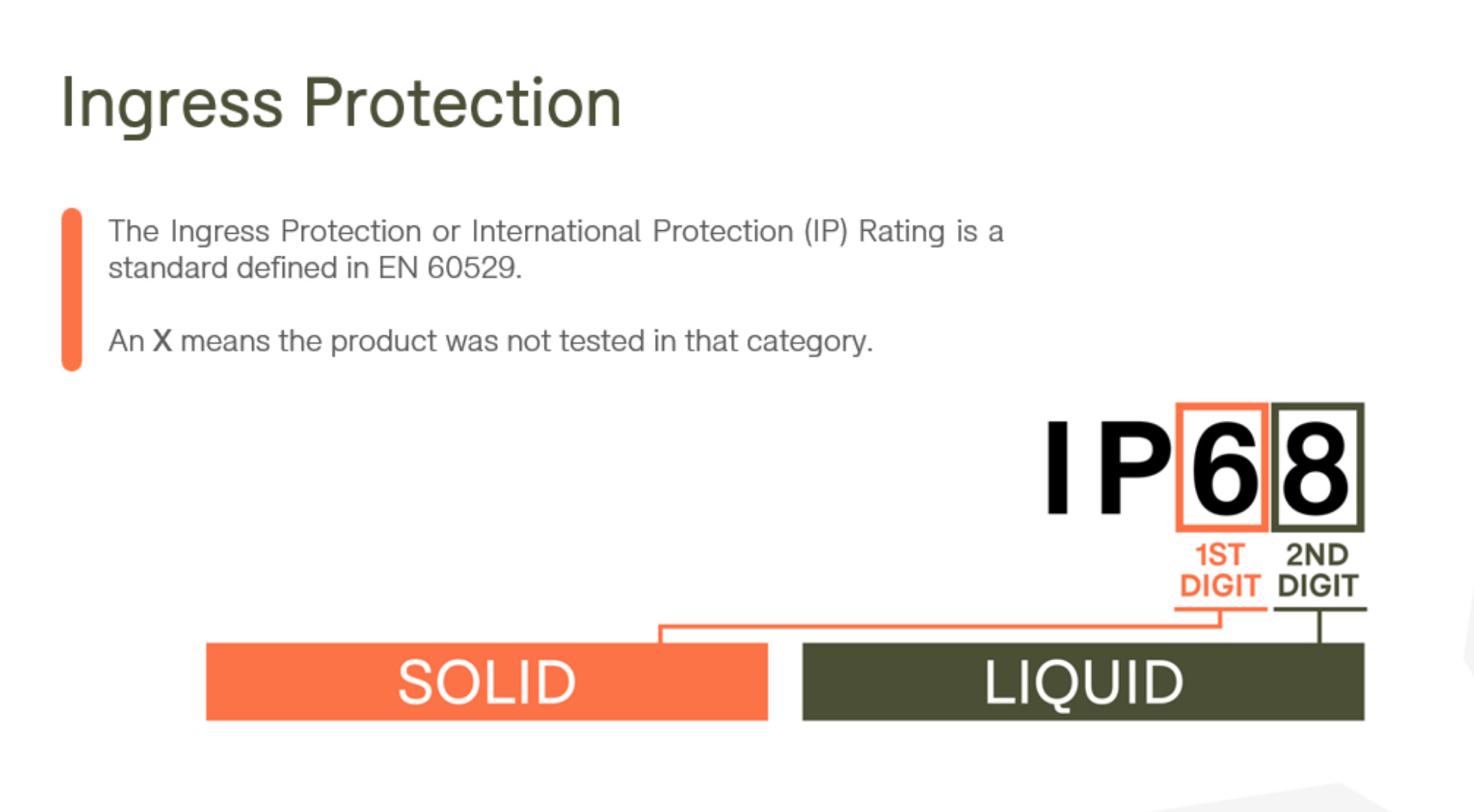 IP Rating System for Drones
IP Rating System for Drones
Importance of IP Ratings
Understanding IP ratings is crucial for drone operators for several reasons:
- Weather Tolerance: Helps identify how well a drone can withstand different weather conditions.
- Operational Safety: Ensures the drone is operated within its environmental limits, preventing damage and ensuring safe flights.
- Informed Decisions: Allows operators to make informed choices about using their drones in environments with dust or moisture.
2. What Do The Two Digits In An IP Rating Represent?
The digits in an IP rating provide specific information about the level of protection a device offers. The first digit indicates protection against solid objects, while the second digit indicates protection against liquids.
First Digit: Protection Against Solid Objects
The first digit in an IP rating, such as IP65, indicates the level of protection against access to hazardous parts (electrical conductors, moving parts, etc.) and the ingress of solid foreign objects. The scale ranges from 0 to 6, with higher numbers indicating greater protection.
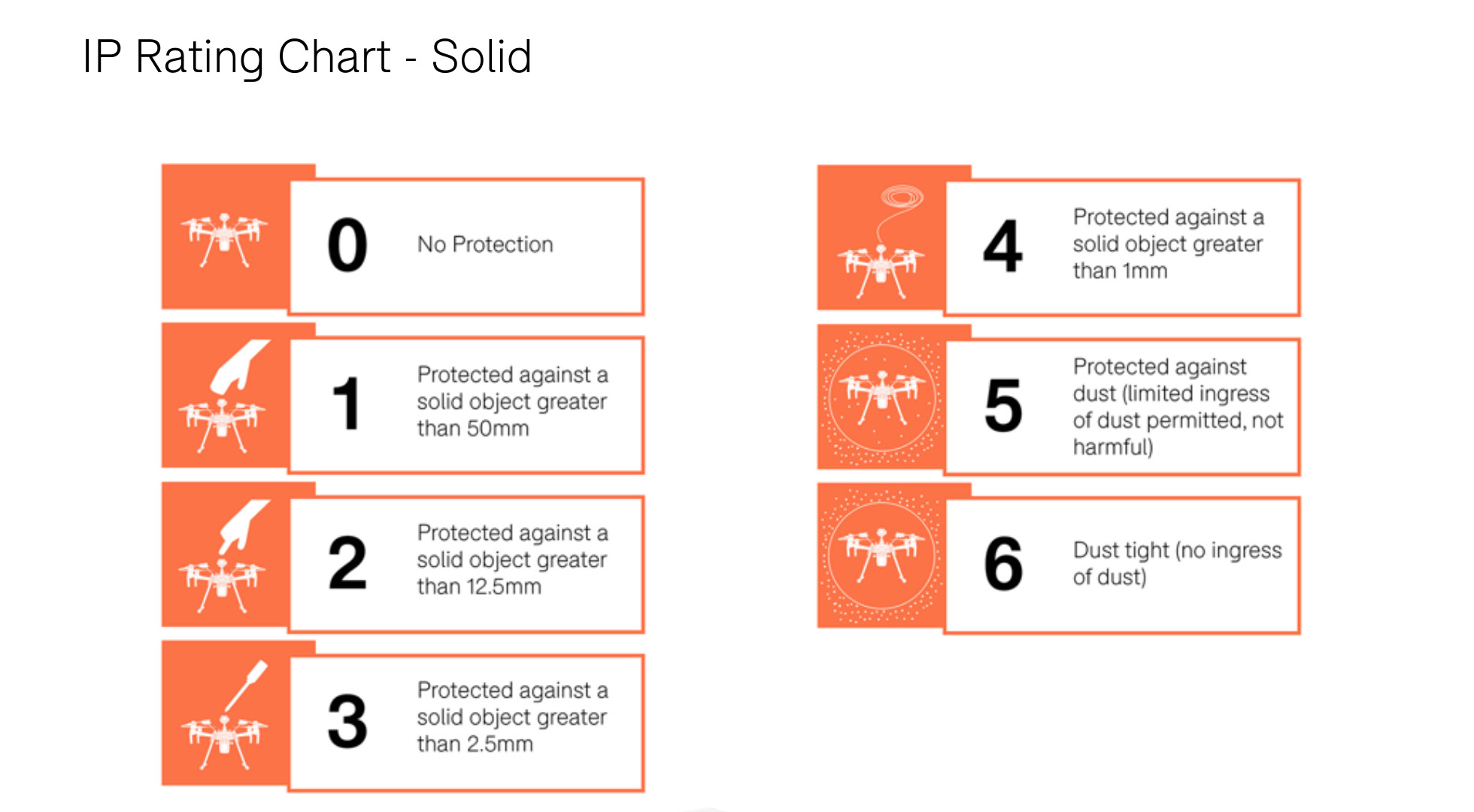 IP Rating for Solid Object Protection
IP Rating for Solid Object Protection
The levels are defined as follows:
| Level | Protection Against | Description |
|---|---|---|
| 0 | No protection | No protection against contact and ingress of objects. |
| 1 | Solid objects greater than 50mm | Protected against solid objects greater than 50mm in diameter. |
| 2 | Solid objects greater than 12.5mm | Protected against solid objects greater than 12.5mm in diameter. |
| 3 | Solid objects greater than 2.5mm | Protected against solid objects greater than 2.5mm in diameter. |
| 4 | Solid objects greater than 1mm | Protected against solid objects greater than 1mm in diameter. |
| 5 | Dust-protected | Ingress of dust is not entirely prevented, but it must not interfere with the satisfactory operation of the equipment. |
| 6 | Dust-tight | No ingress of dust. |
Second Digit: Protection Against Liquids
The second digit in an IP rating, such as IP65, defines the protection of the equipment inside the enclosure against various forms of moisture, ranging from drips and sprays to submersion. The scale ranges from 0 to 9, with higher numbers indicating greater protection.
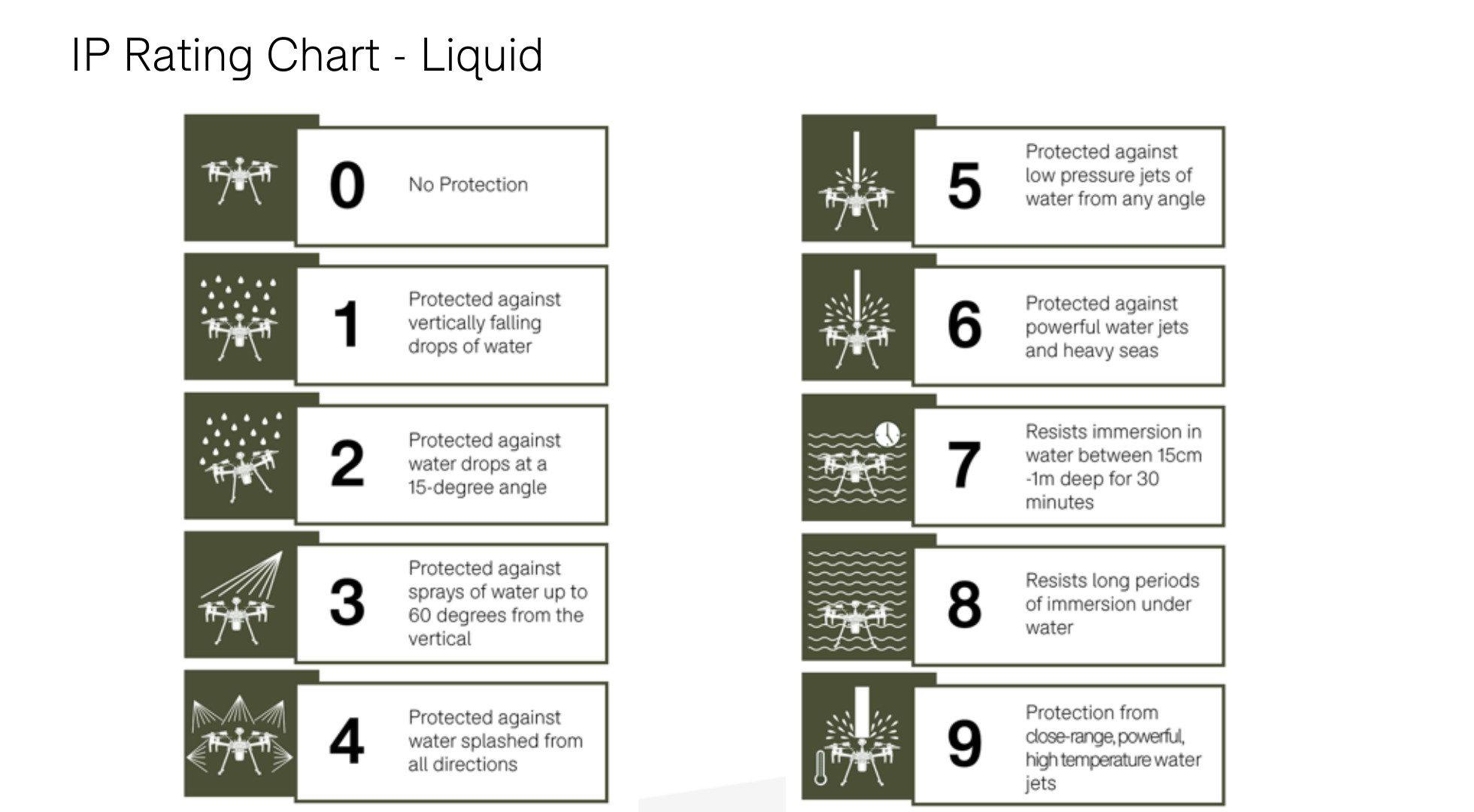 IP Rating for Liquid Protection
IP Rating for Liquid Protection
The levels are defined as follows:
| Level | Protection Against | Description |
|---|---|---|
| 0 | No protection | No protection against water. |
| 1 | Dripping water | Protected against vertically dripping water. |
| 2 | Dripping water when tilted at 15° | Protected against vertically dripping water when the enclosure is tilted at an angle up to 15°. |
| 3 | Spraying water | Protected against spraying water at an angle up to 60°. |
| 4 | Splashing water | Protected against splashing water from any direction. |
| 5 | Water jets | Protected against water jets from any direction. |
| 6 | Powerful water jets | Protected against powerful water jets from any direction. |
| 7 | Immersion up to 1 meter | Protected against the effects of temporary immersion in water at depths of up to 1 meter. |
| 8 | Immersion beyond 1 meter | Protected against the effects of continuous immersion in water at depths beyond 1 meter. The exact conditions are specified by the manufacturer. |
| 9 | Powerful high temperature water jets | Protected against powerful high temperature water jets. |
Additional Letters
In some cases, an additional letter may be at the end of an IP rating, such as IP67M. This letter indicates certified resistance to specific materials or hazards, such as oil or high voltages, or a particular scenario in which the IP testing was conducted. For example, the letter “K” in some IP ratings means that the enclosure provides protection against ingress of directed water jets of high temperature and pressure.
3. How Do IP Ratings Apply to Drones?
Checking the IP rating on your drone is essential for identifying its weather tolerance. A higher IP rating indicates better protection against dust and water, which is particularly important for drone operators who need to fly in unpredictable or harsh environments.
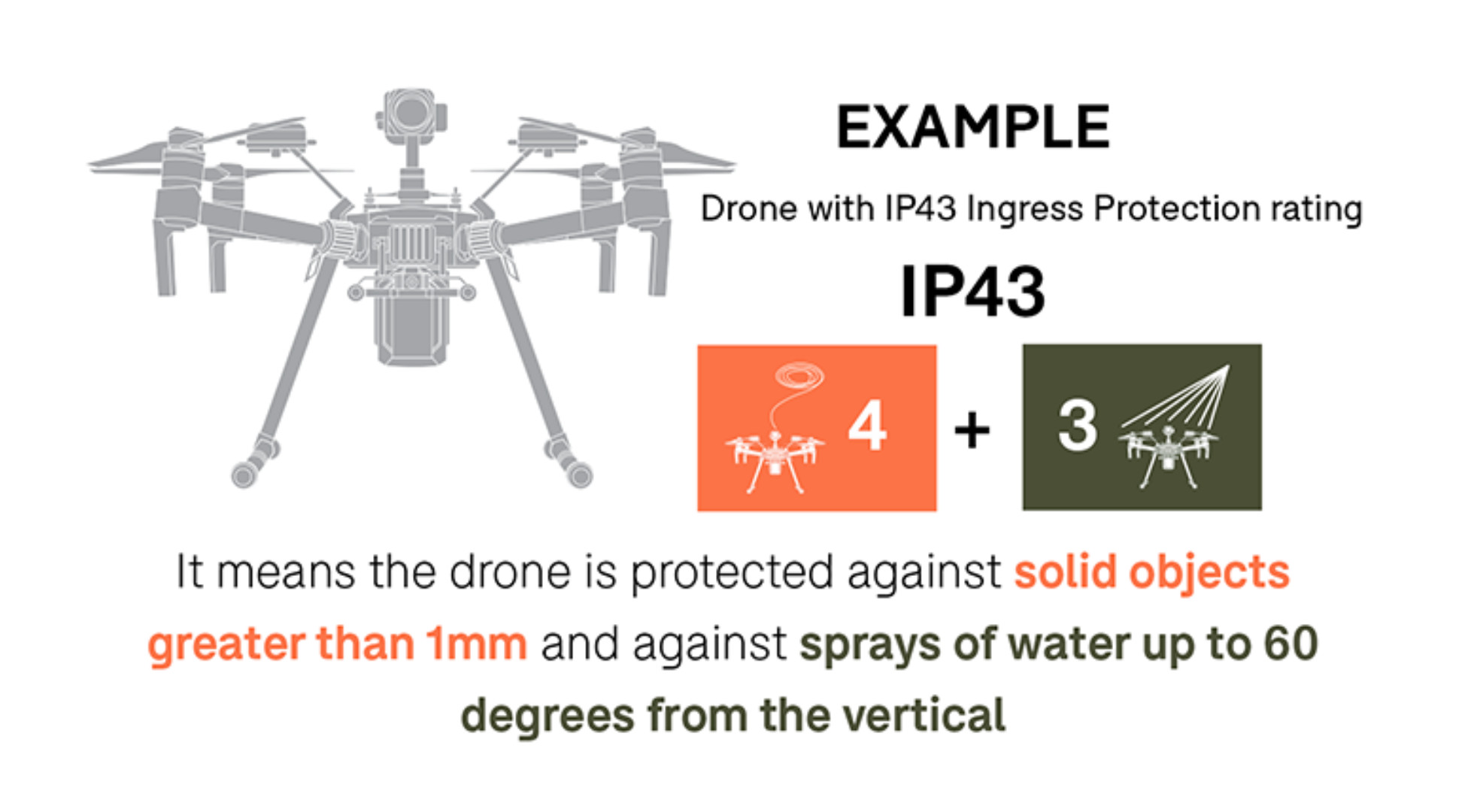 IP Rating Application for Drones
IP Rating Application for Drones
Benefits of a High IP Rating for Drones
A high IP rating ensures that the drone’s motors and enclosed components are protected against dust and rain, making it suitable for various applications:
- Rainy Conditions: Enables flight in light to moderate rain without risking damage to internal components.
- Dusty Environments: Protects the drone in construction sites or other areas with high dust levels.
- Unpredictable Weather: Provides a safety margin when weather conditions might change rapidly.
4. Which DJI Drones Have An IP Rating?
Only a selection of DJI drones have an IP rating, making them more suitable for challenging conditions compared to their non-IP-rated counterparts. These drones are designed with enhanced protection to withstand environmental elements.
DJI Drones with IP Ratings
Here are some DJI drones that have an IP rating:
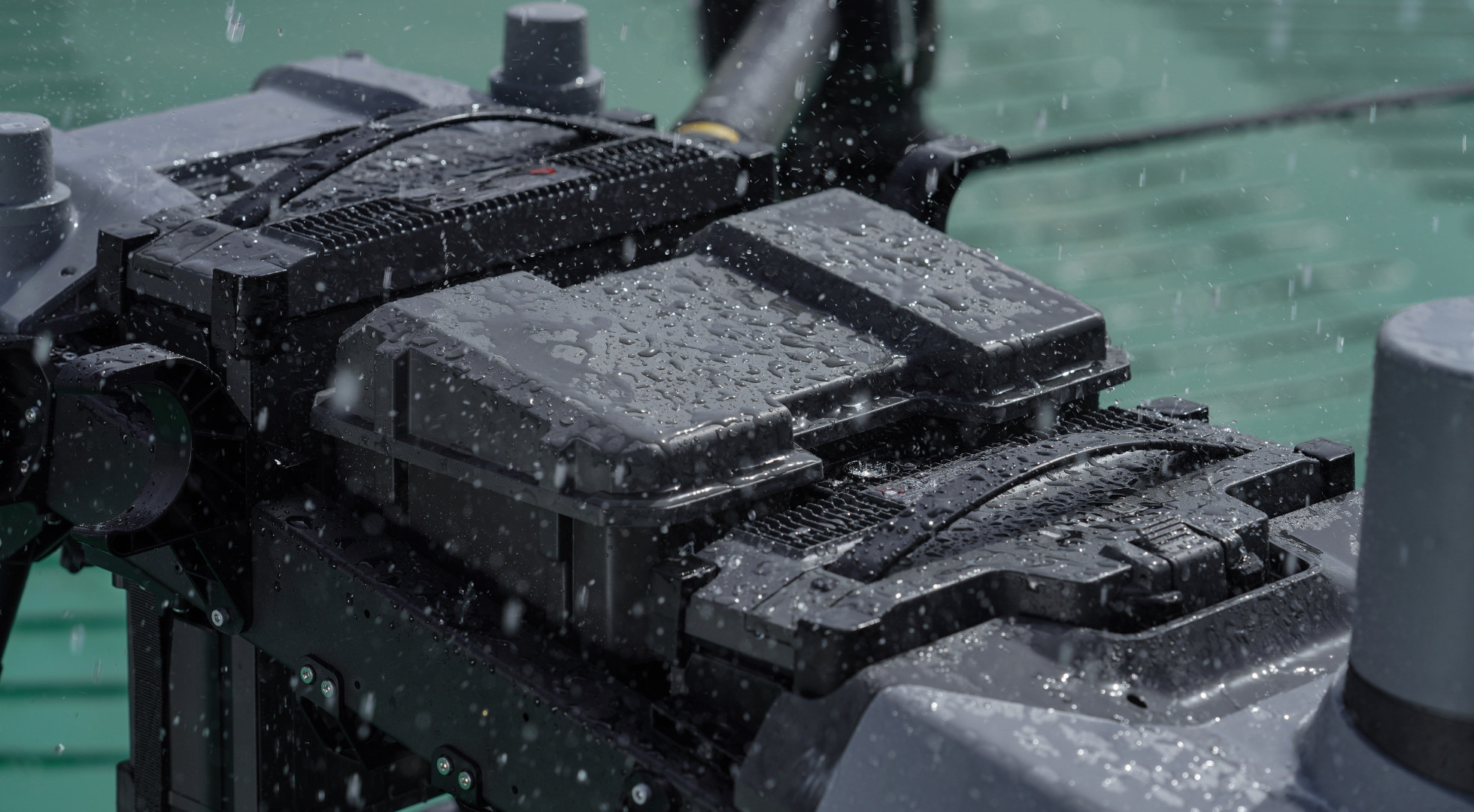 DJI Drones with IP Ratings
DJI Drones with IP Ratings
| Drone Model | IP Rating | Key Features |
|---|---|---|
| DJI Matrice 350 RTK | IP55 | Offers robust protection against dust and water, making it suitable for a wide range of industrial applications. |
| DJI Matrice 300 RTK | IP45 | Provides significant protection against water and dust, ideal for missions in demanding environments. |
| DJI Matrice 30 Series | IP55 | Designed for enterprise use with high environmental protection, ensuring reliability in various weather conditions. |
| DJI Agras T40 | IPX6K | Waterproof design allows direct washdown with water, ideal for agricultural spraying applications. |
| DJI RC Plus | N/A | Weatherproof rating allows for safe operation in rainy conditions, enhancing user experience and reliability. |
Important Note
It is important to note that the IP rating is not permanently effective and may decrease due to product wear and tear. Regular maintenance and inspections are necessary to ensure the drone continues to provide the rated level of protection.
DJI Drones Without IP Ratings
Other DJI aircraft, such as the Mini, Air, Mavic, and Phantom series, do not have an IP rating. It is therefore advised not to fly them in the rain or dusty conditions, as they are not designed to withstand these environmental factors.
DJI Payloads with IP Ratings
A range of DJI payloads have their own IP ratings, enabling them to be used alongside their compatible aircraft in wet weather or dusty conditions. For example, certain Zenmuse cameras offer IP ratings, allowing them to be used on Matrice series drones in challenging environments.
5. Are DJI Drones Waterproof?
While some DJI drones have an IP rating, it doesn’t necessarily make them completely waterproof. Instead, they are water-resistant to varying degrees, depending on their specific IP rating.
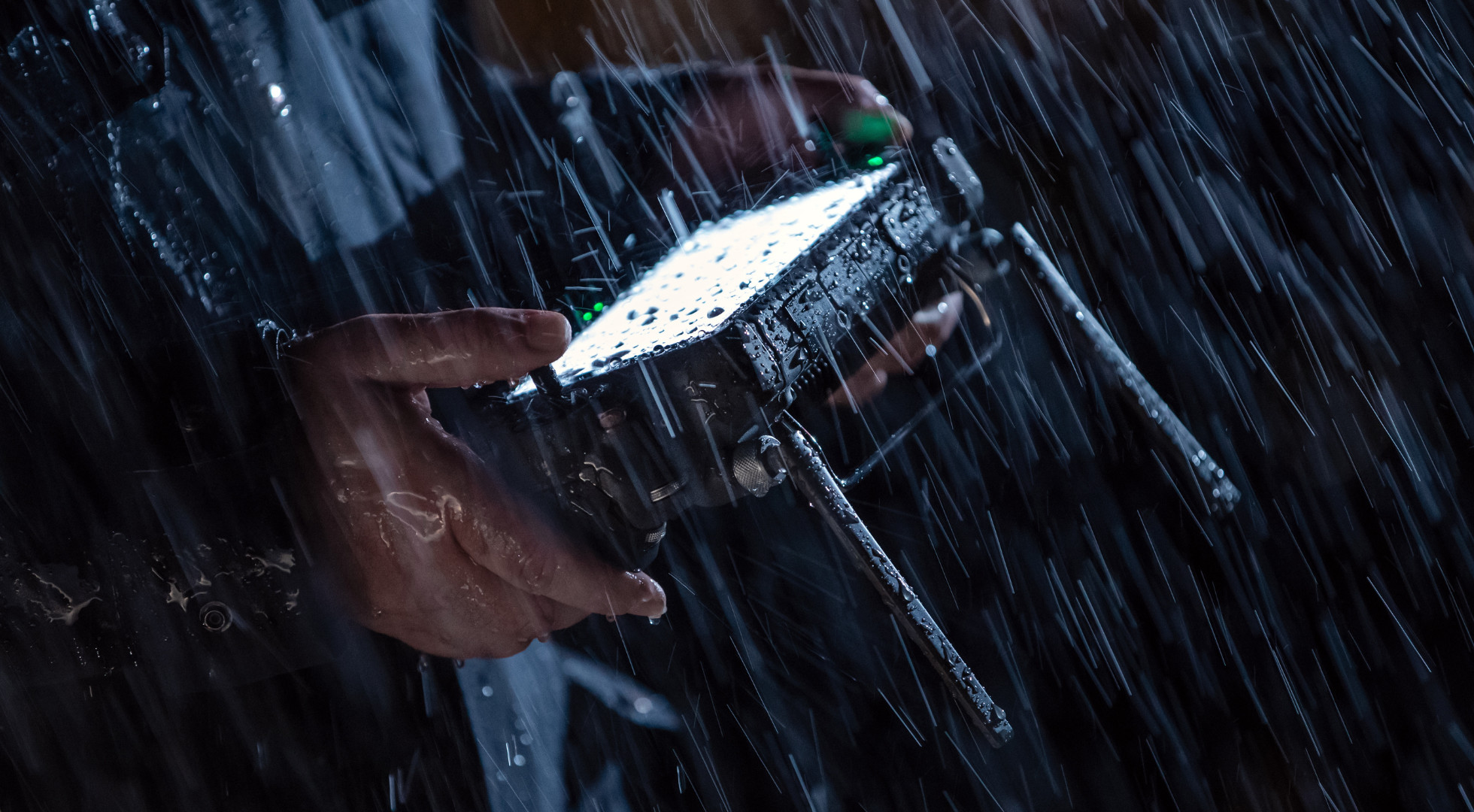 DJI Drones Water Resistance
DJI Drones Water Resistance
Water Resistance vs. Waterproof
- Water Resistance: Indicates that the device can resist the penetration of water to some degree but is not fully protected against immersion.
- Waterproof: Indicates that the device is impenetrable by water and can be submerged without damage.
For instance, DJI states that for IP-rated drones such as the M350 RTK, M300 RTK, and M30 Series, flights should not be conducted when the amount of rainfall exceeds 100mm in 24 hours. However, drones such as the DJI Agras T40 are considered waterproof, as they can be directly washed down with water. Meanwhile, the RC Plus should not be used when precipitation exceeds 50mm in 24 hours.
Operating Drones in Wet Conditions
As mentioned before, drones without an IP rating should not be flown in the rain as they are not considered water-resistant. Operating non-IP-rated drones in wet conditions can lead to:
- Short Circuits: Water can cause electrical components to short circuit, leading to malfunction or permanent damage.
- Corrosion: Moisture can corrode internal parts, reducing the lifespan and performance of the drone.
- Unreliable Performance: Water ingress can affect the drone’s sensors and control systems, leading to erratic behavior and potential crashes.
6. Hints and Tips For Flying DJI Drones In Wet Weather
If you plan to fly a DJI drone with an IP rating in wet weather, there are several precautions you should take to ensure the drone performs well and remains safe.
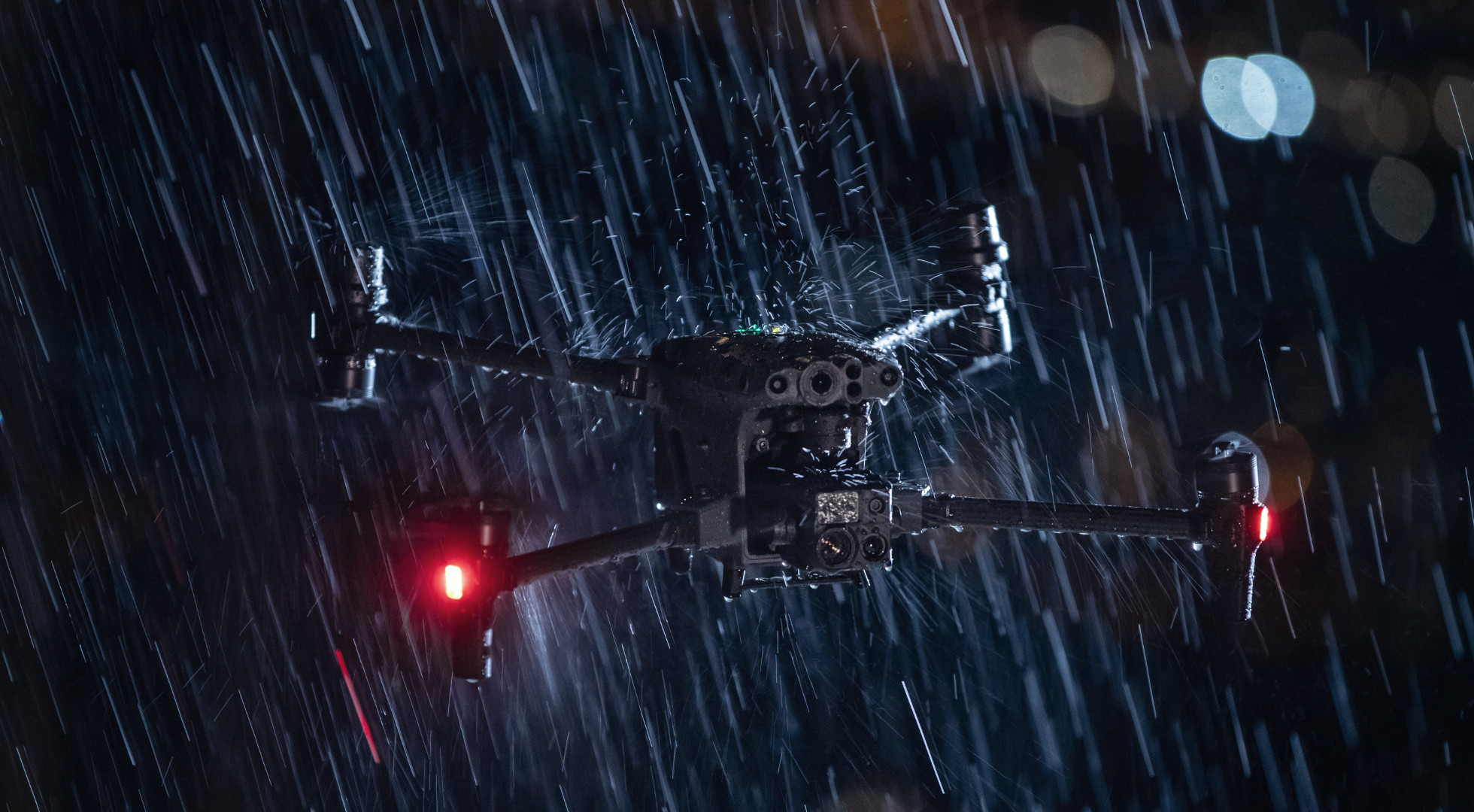 Tips for Flying DJI Drones in Wet Weather
Tips for Flying DJI Drones in Wet Weather
Pre-Flight Checks
- Do not fold the frame arms in the rain: Folding the arms in wet conditions can allow water to enter the internal components.
- Ensure dryness: Make sure the battery ports, battery compartment ports, battery surfaces, and battery compartment surfaces are dry before inserting the batteries.
- Secure the microSD card: Firmly attach the microSD card slot cover to prevent water ingress.
- Check the top shell plug: Ensure the waterproofing top shell plug is firmly attached to the top shell.
- Use recommended batteries: Use the specific DJI batteries recommended for and compatible with the aircraft.
- Inspect the shell: Ensure the aircraft shell is not cracked or the waterproof adhesive is not aged or damaged.
- Payload Preparation: When it comes to payloads, ensure the gimbal port and gimbal surface are free from any liquid before installation.
- DJI Dock Usage: When using DJI Dock, ensure the electrical cabinet door and the dock cover are firmly closed and its waterproof adhesive is intact.
In-Flight Considerations
- Monitor Rainfall: Even with an IP-rated drone, be aware of the rainfall intensity. Avoid flying in conditions where rainfall exceeds the drone’s specified limits (e.g., 100mm in 24 hours for some models).
- Fly with Caution: Operate the drone with extra caution in wet conditions, as the added weight of water droplets can affect flight stability.
- Regular Checks: Periodically check the drone during flight for any signs of water ingress or unusual behavior.
Post-Flight Maintenance
- Dry the Drone: After flying in wet conditions, thoroughly dry the drone with a soft, absorbent cloth.
- Remove Battery: Remove the battery and allow the battery compartment to air dry.
- Inspect Components: Inspect all components, including motors and connectors, for any signs of moisture or corrosion.
- Store Properly: Store the drone in a dry, climate-controlled environment to prevent moisture buildup.
7. Benefits of Flying IP-Rated Drones
Flying drones with an IP rating offers several key advantages, particularly in industries and applications where environmental conditions are unpredictable or harsh.
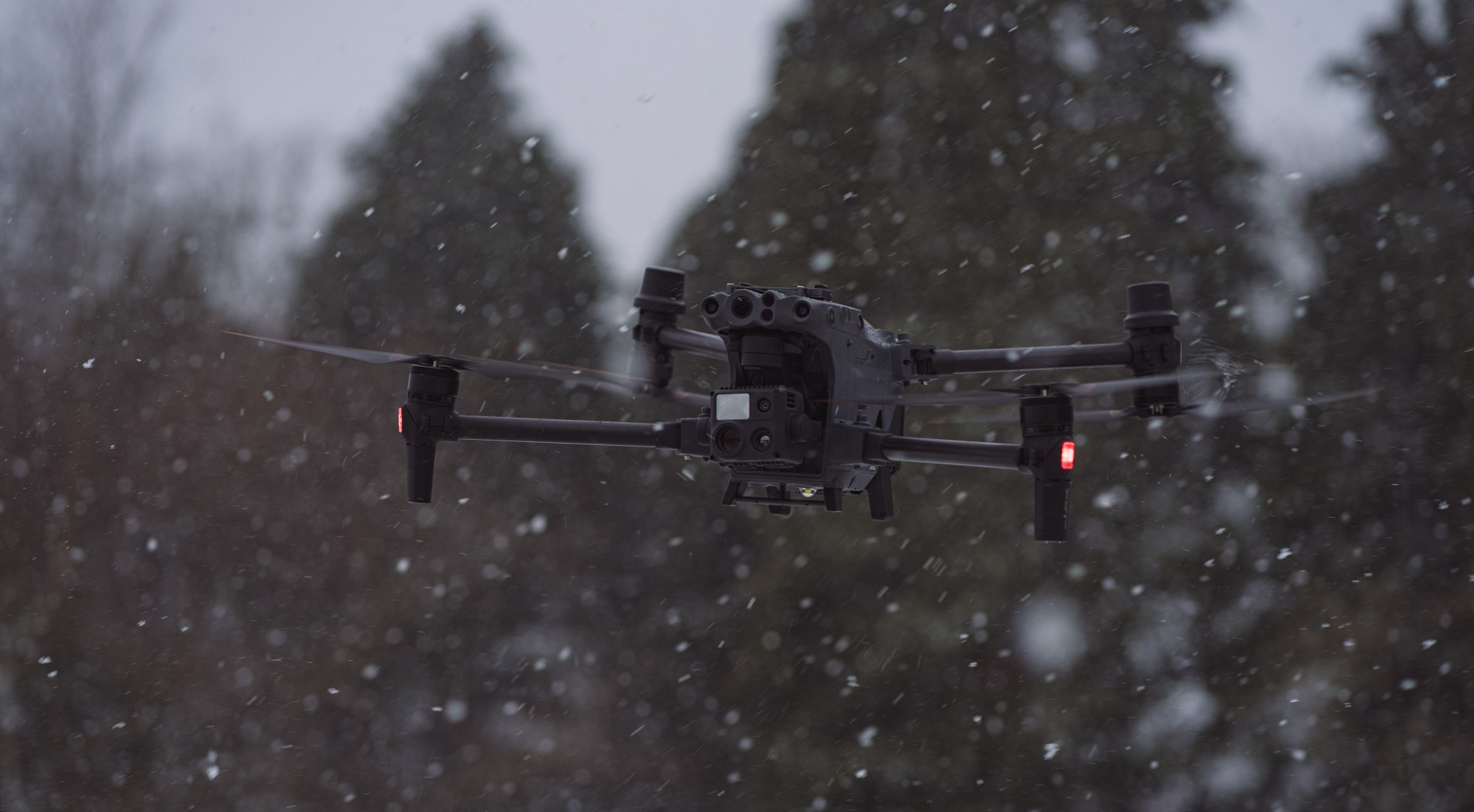 Benefits of IP Rated Drones
Benefits of IP Rated Drones
Extended Operational Window
IP-rated drones can operate in a wider range of weather conditions, reducing downtime and increasing productivity. This is especially beneficial for industries such as:
- Construction: Monitoring progress and conducting inspections in dusty or light rain conditions.
- Agriculture: Spraying crops and assessing field conditions, even with light rain or dew.
- Infrastructure Inspection: Inspecting bridges, power lines, and other critical infrastructure in various weather conditions.
Reduced Risk of Damage
The enhanced protection provided by IP ratings reduces the risk of water and dust damage, leading to fewer repairs and a longer lifespan for the drone. This translates to:
- Lower Maintenance Costs: Less frequent repairs and replacements.
- Increased Reliability: Consistent performance in challenging environments.
- Better Return on Investment: Longer operational life and reduced downtime.
Enhanced Safety
Operating drones in adverse conditions can be risky if the equipment is not designed to handle it. IP-rated drones provide a safer and more reliable option, reducing the likelihood of malfunctions or crashes due to environmental factors.
8. Understanding Specific IP Ratings
To fully leverage the benefits of IP-rated drones, it’s essential to understand what specific IP ratings mean in practical terms. Here are some common IP ratings and their implications for drone operations:
IP45: Protected Against Solid Objects and Water
- Solid Object Protection: Protected against solid objects greater than 1mm in diameter.
- Water Protection: Protected against water jets from any direction.
- Application: Suitable for use in light rain and dusty conditions. Commonly found in drones used for general inspection and surveillance.
IP55: Dust-Protected and Water-Resistant
- Solid Object Protection: Dust-protected, meaning dust ingress is not entirely prevented, but it must not interfere with the satisfactory operation of the equipment.
- Water Protection: Protected against water jets from any direction.
- Application: Ideal for construction sites and agricultural environments where dust and occasional rain are common.
IP67: Dust-Tight and Immersion Protected
- Solid Object Protection: Dust-tight, meaning no ingress of dust.
- Water Protection: Protected against the effects of temporary immersion in water at depths of up to 1 meter.
- Application: Suitable for more demanding environments where the drone may encounter heavier rain or accidental submersion.
IPX6K: Powerful High Temperature Water Jets
- Solid Object Protection: Not specified, indicated by the “X.”
- Water Protection: Protected against powerful high-temperature water jets.
- Application: Designed to withstand high-pressure washdowns, making it ideal for agricultural drones that require regular cleaning.
9. Maintenance Tips for IP-Rated Drones
Even with an IP rating, regular maintenance is crucial to ensure the drone continues to provide the intended level of protection. Here are some maintenance tips to follow:
Regular Inspections
- Check Seals: Regularly inspect seals and gaskets around hatches, battery compartments, and connectors to ensure they are intact and free from damage.
- Inspect Housing: Examine the drone’s housing for cracks, dents, or other signs of damage that could compromise its IP rating.
- Assess Connectors: Ensure all connectors are properly seated and free from corrosion.
Cleaning Procedures
- Use Appropriate Cleaners: Use only mild detergents and cleaning solutions recommended by the manufacturer. Avoid harsh chemicals that could damage seals or housing materials.
- Gentle Cleaning: Clean the drone gently with a soft cloth or brush. Avoid using high-pressure washers unless the drone is specifically designed for it.
- Dry Thoroughly: After cleaning, dry the drone thoroughly with a clean, absorbent cloth.
Storage Practices
- Dry Environment: Store the drone in a dry, climate-controlled environment to prevent moisture buildup and corrosion.
- Protective Case: Use a protective case or bag to shield the drone from dust and physical damage during storage and transport.
Seal Maintenance
- Lubricate Seals: Periodically lubricate seals and gaskets with a silicone-based lubricant to keep them supple and prevent cracking.
- Replace Damaged Seals: Replace any damaged or worn seals promptly to maintain the drone’s IP rating.
10. Case Studies: IP-Rated Drones in Action
To illustrate the real-world benefits of using IP-rated drones, here are a few case studies from various industries:
Case Study 1: Construction Site Monitoring
- Challenge: A construction company needed to monitor progress on a large-scale project, but dust and occasional rain made it difficult to use standard drones.
- Solution: The company deployed a DJI Matrice 300 RTK with an IP45 rating. The drone was able to operate reliably in the dusty environment and light rain, providing consistent aerial imagery and data.
- Results: The company was able to track progress more efficiently, identify potential issues early, and reduce the risk of delays.
Case Study 2: Agricultural Spraying
- Challenge: A farmer needed to spray crops but wanted a drone that could withstand regular washdowns and occasional rain.
- Solution: The farmer used a DJI Agras T40 with an IPX6K rating. The drone’s waterproof design allowed for easy cleaning after each use, and it could operate reliably in light rain.
- Results: The farmer was able to spray crops more efficiently, reduce water usage, and minimize the risk of equipment damage.
Case Study 3: Infrastructure Inspection
- Challenge: An infrastructure company needed to inspect bridges and power lines in various weather conditions, including rain and wind.
- Solution: The company used a DJI Matrice 350 RTK with an IP55 rating. The drone’s robust design and weather resistance allowed it to operate safely and reliably, even in challenging conditions.
- Results: The company was able to conduct inspections more quickly, identify potential issues before they became critical, and improve overall safety.
By understanding IP ratings and choosing the right drone for the job, operators can ensure they are equipped to handle a wide range of environmental conditions, maximizing productivity and minimizing the risk of damage.
Navigating the world of drone technology and ensuring your equipment is ready for any condition can be challenging. Flyermedia.net is your premier source for in-depth information, expert advice, and the latest innovations in the drone industry. Whether you’re looking for the best IP-rated drones or need tips on maintaining your equipment, we’ve got you covered.
Ready to elevate your drone operations? Visit Flyermedia.net today to explore our extensive resources, connect with industry experts, and discover how to make the most of your drone technology. Fly smarter, fly safer, with flyermedia.net. Address: 600 S Clyde Morris Blvd, Daytona Beach, FL 32114, United States. Phone: +1 (386) 226-6000.
FAQ: Flying DJI Drones in the Rain
1. What does IP rating mean for DJI drones?
An IP (Ingress Protection) rating indicates the level of protection a DJI drone has against dust and water. The rating consists of two digits, with the first indicating protection against solid objects and the second against liquids.
2. Can I fly my DJI drone in the rain if it has an IP rating?
Yes, if your DJI drone has an IP rating, it means it has been tested and certified to withstand certain levels of water exposure. However, you should still check the specific IP rating and the manufacturer’s guidelines to understand the limitations.
3. What happens if I fly a DJI drone without an IP rating in the rain?
Flying a DJI drone without an IP rating in the rain can cause significant damage to the drone’s internal components, leading to malfunctions, short circuits, and corrosion. It is not recommended to fly non-IP-rated drones in wet conditions.
4. How do I interpret the digits in an IP rating for a DJI drone?
The first digit indicates the level of protection against solid objects, ranging from 0 (no protection) to 6 (dust-tight). The second digit indicates the level of protection against liquids, ranging from 0 (no protection) to 9 (powerful high-temperature water jets).
5. Which DJI drones have the highest IP rating?
DJI drones with high IP ratings include the Matrice 350 RTK (IP55), Matrice 300 RTK (IP45), and Matrice 30 Series (IP55). These drones are designed for industrial applications and can withstand challenging environmental conditions.
6. Is there a difference between water resistance and waterproof for DJI drones?
Yes, water resistance means the drone can resist the penetration of water to some degree but is not fully protected against immersion. Waterproof means the drone is impenetrable by water and can be submerged without damage.
7. What pre-flight checks should I perform before flying my IP-rated DJI drone in the rain?
Before flying, ensure that the battery ports and battery compartment are dry, the microSD card slot cover is firmly attached, the waterproofing top shell plug is secure, and the aircraft shell is not cracked or damaged.
8. Can I use any battery with my IP-rated DJI drone when flying in wet conditions?
No, always use the specific DJI batteries recommended for and compatible with your aircraft to ensure proper sealing and protection against water ingress.
9. What should I do after flying my IP-rated DJI drone in the rain?
After flying in wet conditions, thoroughly dry the drone with a soft cloth, remove the battery and allow the compartment to air dry, inspect all components for moisture or corrosion, and store the drone in a dry environment.
10. Where can I find more information about the IP rating of my DJI drone?
You can find detailed information about the IP rating of your DJI drone in the product manual or on the DJI website. Always refer to the manufacturer’s guidelines for specific recommendations and limitations.